
For over 30 years Carol has looked after the garden which is loved not only by herself but her family too and she knows every part of the soil and the plants.
She loves spending time in the garden and enjoying the peace of the surrounding countryside.
Every season brings delight, challenges and problems 'but that's the thing about gardening, it's ever-changing and its's always exhilarating.
Over the 6 episodes Carol is going to show a whole year in the garden 'how it grows, flourishes, dies and is reborn.
May and June are the time the garden where the garden is lush and growing fast and there is so much to do as well as preparing for other seasons.
It is also important to take time to enjoy this time in the garden.
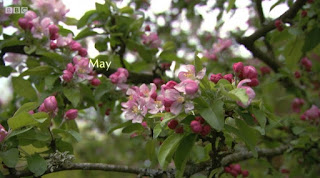
May is about abundance, with branches covered in blossom and the hedgerows thick with Hawthorn blossom and the ditches full of Cow Parsley.
The leaves on the trees are all new and fresh.
Spring is a time to get out and about with so much to see and Carol is out with her dog in the woods surrounded by stunning Bluebells.
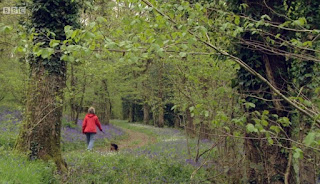
Woodlands are magical places and they are Carol's favourite place to be deep in a wood.
She says you can forget everything as its so tranquil and can also hear the earth breathing.
Devon woodlands are extra magical due to the climate as it is kind to the trees and plants in the wood.
The Bluebells and ferns are stunning and the ferns have a special place in her garden.
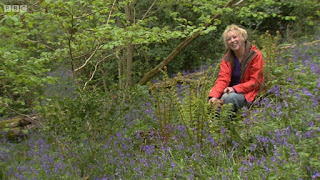
Her woodland garden is also full of ferns that are bursting into fresh life and it is has had a succession of plants this year starting with the Snowdrops.
Hellebores followed then the Primroses and now the Spring finale of Bluebells, Aquilegias, Woodruff and Foxgloves.
Carol prefers white Foxgloves but they all fit in well in her garden and they are biannual so the first year they grow and set and in the second year the towering flower spikes form.

They then set seed and die and Carol every year sows their collected seeds in a seed bed or tray.
When they start growing Carol can see by the redness of the leaves which ones will be pink so they are destined for her native hedge, the white ones take pride of place and are planted out in the Autumn or following Spring.
The cycle then begins again.
Red Banana
Every year there are things that goes right and wrong in the garden but Carol did not expect it to go wrong with her exotics she was preparing for her hot border.
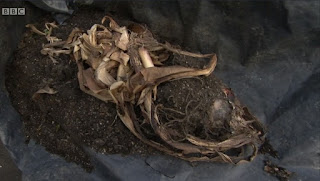
Her Red Banana has not made it, the root ball has disintegrated and the foliage is all dry and dead.
She has had it for 4 years and the base is saturated with water and rotten so sadly it is thrown on the compost heap.
Hot Borders
The garden is full of fresh green leaves but this morning there was still a frost on the field next door.
All the plants are hot colours like Rheums and Lobelia Tupa which is trying to escape out the sides of the sleeper supports
.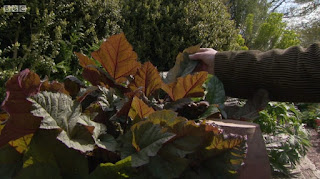

Today she is planting Rudbeckia a big yellow daisy that wont flower yet until the Cannas and Dahlias are out.
The Hedge Sparrow have fledge from there nest so Carol can work in that area again and she is planting the Rudbeckia to link both sides of the garden together.
She has also planted a Poppy that used to be called 'Beauty of Livermere' but it is now called Goliath Group.
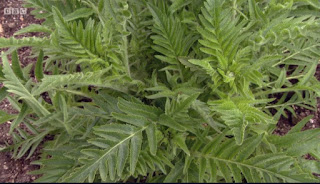
It will grow into a big poppy with bright red flowers but at the moment it has just started making its tap roots and after just 1 week it has grown a foot and needs staking.
Carol next job is in the raised bed which she built 25 years ago and needed an area to grow plants that she cannot grow in any other part of the garden.
She has a Pulsatilla and Eriogonum and is adding three Phlomis Lanata which are to replace the ones that died in the last winter.

Luckily Carol had propagated some more just in case something happens to her plants.
The bed in the Summer is in full sun and her Mexican Fleabane Erigeron Karvinskianus and in full Summer the wall is full of pink and white daisy flowers.
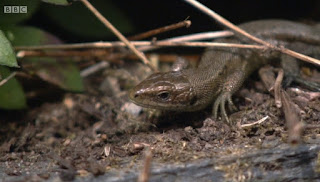
Last Winter she wonders if she had lost it but it is already starting to appear again and its also the perfect home for the Lizards in the garden.

The garden is alive with the hum of insects and her Husband Neil is very fond of bees.
Last year a swarm of bees were in one the trees but it was a small swarm and the bad Winter unfortunately killed them.
They have invited Beekeeper Bill Chandler to show them how to keep bees the natural way in the garden.

Carol watches them build the hive and asks Bill why he brought the bees to the garden the day before.
He says it is to get them settled and orientated.
The hive is trough shaped and will be put in the same place as the bees travelling box for the changeover.
It is called a top bar hive and the bees build their combs hanging from a wooden bar that goes across the top.
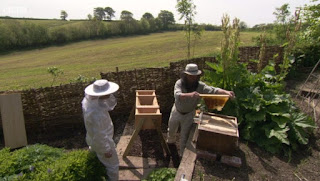
Bill and Neil don their bee keeping protective clothing to put the new hive in place and take old combs from the travel box and put them in the new hive.
They locate the Queen that is longer than the other bees and you never touch a queen bee and they puff the bees with icing sugar to calm them which is nicer than smoke as they just then groom each other.

The late frosts have gone and it is June and when it should be gloriously sunny it is pouring with rain.
For the last 20 years for the last week in May, Carol has been away at the Chelsea Flower Show, so when she comes back the garden has been transformed with the arrival of June.

The poppy she staked back in May is now in glorious flower, there was one she missed and that was laying on the ground so she has quickly temporary staked it to get it upright.
She trims off any overly tall stakes so she can no longer see them and have them distract from the plants.
She pruned the Cotinus earlier but now it is in leaf she just has to tidy up the small stems that have not grown.
It makes a lovely backdrop for the poppies.
Alice's Garden

Summer follows on so quickly from Spring and in Alice's Garden this is very apparent.
The garden is packed full of plants that remind Carol of her daughter with crimson white and pink flowers.
It is all soft shaped and white Phlox runs through the garden and is Alice's Grandmas plant.
Another plant that is abundant in the garden is White Geraniums and the one thats at its best is Geranium Sanguineum Alba.

The flower that typifies Alice's garden is the Rose Rosa Mundi that was planted for the reason that her second name is Rosamund it has beautiful pink and white flowers and is at its best in her birthday month of June.
Bare Root Cuttings
Herbaceous plants like Ornamental Poppies, Crambe and Acanthus have long fleshy roots that means they are perfect for root cuttings.
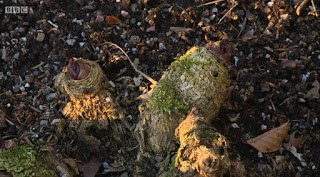
Earlier in the year she exposed the roots of Crambe and severed them and cut them into sections and popped them in gritty compost in a seed tray.
It takes 3 - 4 weeks before the top growth begins to grow and then its a while before the roots develop and they can be potted on.

They can be ready to plant out in the Autumn or the following Spring.
After a couple of years you will have a huge plant covered in flowers.
Carol has a gravel track all the way through the garden and plants self seed in the gravel and she remembers the first time a Geranium appeared by the kitchen and they manage to form beautiful self seeded arrangements.
She just leaves them be and there is a lovely arrangement of Fennel with Geraniums breaking up the path.

Sometimes they do need maintenance when they are in the way or not going to flourish where they are.
She digs into the gravel with a little fork to dig up Geranium Nodosum that is shade loving and she pops it in a pot and covers it with gravel.
Such free bounty from the garden in new plants.
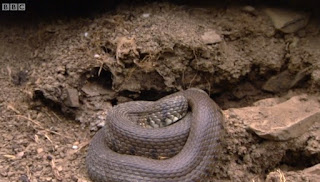
Carol lifts back some plastic to reveal a big Grass Snake it is under where they grow trailing Pumpkins that she needs to water.
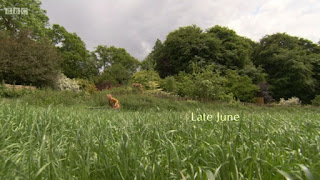
Compost is the heart of her garden and a never ending job and Carol shows us her current compost heap where she been collecting nettles and chards and lots of lovely green stuff.
This is a fast compost heat that was only built in the last few weeks and she does this every Summer with the green stuff out of the garden and the layer underneath is made up of brown stuff.

The brown stuff is made up of twigs and muck and this adds to the heating process.
'Compost is the life blood of my garden'.
Without it Carol says she couldn't grow stuff as she tries to run the wheelbarrow up the heap.
She manages to add to the thick layer of green stuff which she will then cover with more brown stuff.

Nettles are one of the best things to add to the compost as they have all sorts of nutrients and base elements.
The day before was the Summer Solstice, the longest day of daylight hours in the year and the garden has changed so much in June from May.
In May you could easily walk around the garden now the plants are starting to grow and spread with the different textures and scents filling the garden.

June is a lovely month with the smell of Honeysuckle but Carol is looking forward to the Summer to come and the garden exploding during the hot summer days.
But for now Carol is happy to enjoy this wonderful time in the garden.
All Photographs are Copyright of BBC.com

No comments:
Post a Comment